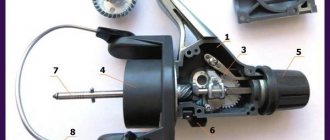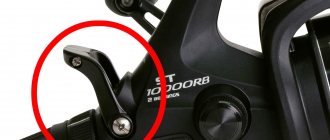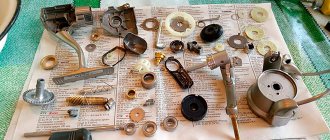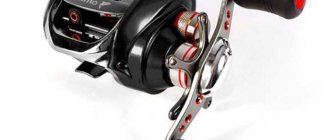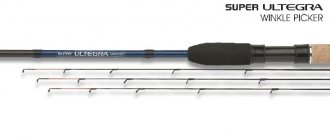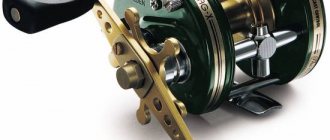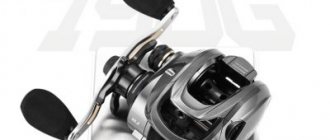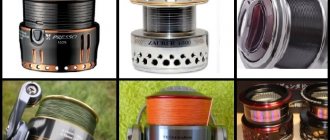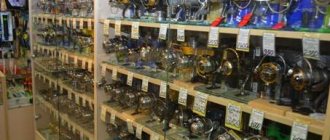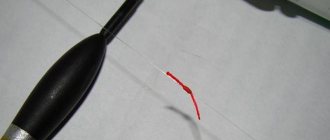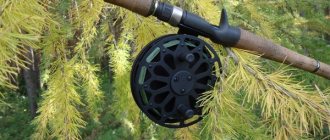Parts of the spinning reel mechanism
A spinning reel for various types of fishing rods is the most common device for casting and guiding fishing line when using spinners and wobblers. This mechanism is also used when fishing with float and bottom tackle.
Unlike a drum reel, a spinning reel with a fixed spool has a complex mechanism that consists of several dozen parts.
Frame
This part of the reel houses all the mechanisms that allow you to wind and pass the fishing line. The body is made of hard materials - alloys of various metals, plastics, carbon fiber. It is securely attached to the base of the rod.
The housing contains shafts and gears driven by a handle. This part of the spinning reel must be durable and withstand heavy loads when casting gear and landing fish.
Spinning reel
Materials used in the manufacture of spinning reel bodies:
- plastic - durable types of this material are used in the manufacture of inexpensive models intended for float fishing;
- aluminum alloys - reel bodies made of this material are able to withstand heavy loads, but are prone to mechanical damage;
- carbon fiber plastic – lighter than alloys made of aluminum and other metals, bodies made of this material are durable and have improved resistance to damage;
- titanium alloys - used for high-class spinning gear; the bodies are light and especially durable.
The most common spinning reels are made of carbon fiber. They are used for all types of spinning fishing.
Bearings
These are important elements in the mechanism of a spinning reel. The operation of the shaft, handle, driven axis, and coil rotor depends on them. Even the cheapest models have a roller bearing in the reverse clutch. The remaining parts can be replaced with bushings.
It is believed that the more bearings there are in a spinning reel, the more reliable the operation of the entire mechanism. Manufacturers place this part on the axis of the rotation handle, the central shaft, the driven axis, and the rotation rotor. The line laying mechanism is also equipped with this element.
Shimano reel with rear clutch
Expensive reels have at least 5 bearings. Depending on the design features, there may be 7 or more elements. These parts contribute to the smooth operation of all parts of the mechanism.
On branded models there is a designation of the number of bearings in the reel mechanism. This marking is located on the body or on the spool.
Gears
The mechanism is based on a pair of toothed gears. One of them is the driving one, standing on the rotation handle, the other is the driven one, on the main shaft.
When the handle rotates, the drive gear transmits the direction of movement of the driven gear on the reel shaft. The line is wound onto a stationary spool. This mechanism is called the main pair.
When float fishing, when the catch is small, the reel serves only to guide the fishing line. When fishing, when large specimens are biting, the spinner has to overcome the opponent’s resistance. The force that the reel withstands when winding the fishing line depends on the size of the gears of the main pair. The larger it is, the more powerful the mechanism.
Line laying machine
This is a separate unit that is part of the inertialess reel mechanism. He is responsible for winding the fishing line and evenly laying it on the spool. The rotating handle drives the central shaft through the main pair of gears.
The shaft rotates the line-laying mechanism. When the bow is closed, the line falls on the roller and is wound onto the spool. To ensure an even position, the drum moves forward and backward.
The spool remains motionless. When preparing to cast, the spinner pulls the line with the index finger of his right hand and fixes it on the bend. The safety bracket rises. During casting, the cord slides freely.
When the handle is turned, a mechanism is activated that brings the bracket into the working position. The line roller drum rotates, the roller picks up the fishing line and evenly winds it onto the spool.
Line roller
This is an important element of the forest laying mechanism. The roller bears the load when winding the fishing line onto the spool. In this case, the part experiences heavy loads. On inexpensive models, the element is stationary or a bushing is inserted inside it instead of a bearing.
Spinning reel (disassembled)
In most reels of the mid-price category and above, the roller rotates when winding the line. Its design uses a bearing, which reduces wear of the part during intensive work and heavy loads.
Backstop
When fishing with the reel handle, the line can be wound onto the spool and released. To prevent the reel from rotating during sharp hookings, releasing the fishing line, a reverse stopper is used. Another name for the mechanism is anti-reverse.
There is an anti-reverse switch. A spinner can use it when trolling or fishing with float tackle. The lever that sets this mode is located on the back or bottom of the case.
Lever
By rotating the handle, the main shaft of the reel is driven through a pair of gears. He turns the rotor. The spool feeds back and forth, distributing the line evenly.
For the convenience of the spinner, the handle can be attached to the left or right side of the body. The part may fold during transportation. To do this, you need to loosen the clamping screw or press a special button.
The part of the handle that the spinning angler holds while rotating is called the fungus. This element is located on an axis, inside of which there is a bushing or bearing.
The main part of the handle, located between the fungus and the folding mechanism, is the shoulder. A tetrahedral axis is attached to its base, passing through the coil body. It sets the direction of movement for a pair of gears. They rotate the main shaft.
When hooking and retrieving, by rotating the handle, the spinner can tactilely determine the load from the resistance of the caught fish.
Spool
A cylindrical element on which the fishing line is wound. A rotor rotated by the main shaft drives the spool back and forth. At this time, the drum is used to lay the timber.
The spool is a removable part and can be easily replaced during fishing. Spinners have several elements in stock with pre-wound fishing lines of various sections.
The spool is equipped with a friction mechanism that prevents it from rotating when winding the fishing line. A special regulator is installed on the reels, which allows you to set the maximum load at which the cord will release very slowly.
The regulator allows you to avoid critical loads that can cause the line to break. This mechanism is used when fishing for large fish. You can use it when trying to free the tackle when it gets caught on bottom vegetation and driftwood.
A novice fishing enthusiast can learn from the video how to tie a cord to a spinning reel and how to set up a spinning reel. These videos show the maintenance, disassembly and assembly of a spinning reel.
Coil design - reverse stopper
- VK
Currently, the vast majority of fishing reels are free to rotate in one direction only. Moreover, this applies to reels of any type - inertia-free, multiplier, and even those that are usually called simply “wheel”.
The device, which until recently many fishing reel manufacturers used to attract consumers in their advertising brochures, was called Instant Antireverse, which in Russian means “instant reverse stopper.” It is used both in the “inertia-free” rotor and in the spool of inertial reels (with and without a drive). The design of this device, apparently, was clearly borrowed from the freewheel hub of the rear wheel of a bicycle and turned out to be so simple and practical that it extended even to the most conservative of reels - fly fishing, to which it added another consumer option. But before we look more closely into the belly of the “instant anti-reverse”, we should remember its predecessors, many of which are still in service with fishermen.
Tooth for tooth
Appeared in the 50s of the XX century. Inertialess reels initially did not have a device at all that prevented the rotor cup from rotating in the direction opposite to the winding of the fishing line. This “meat grinder” quickly gained popularity due to the fact that casting with it practically did not require serious training (within an hour of practice, even ladies and small children became spinning players), and immediately began to improve in every way. One of the first innovations was the reverse rotation stopper... the handle that operated the entire mechanism. That is, the device was mounted on the axis of the reel handle and blocked its rotation in the “wrong” direction. In its simplest form, it was a finned or star-shaped disc with a thread on the handle axis, which essentially served as a locknut. If it was necessary to stop the rotation of the line guide cup for unwinding, you could, without taking your hand off the reel, lightly turn this figured nut with one finger and simply jam the rotation of the mechanism.
However, most consumers did not like this device, and then an ancient ratchet was introduced instead - a movable tooth located on the reel body that falls on the teeth of the main gear (or grooves on its axis). It could be turned on or off at will. When engaged, the ratchet lever locked the gear, allowing it to rotate in one direction only. On simple inertial reels such as wire and its analogues, this system is successfully used to this day (1), and in fly fishing reels, although with minor additions, it also remains very popular (2).
1. Conventional wire reel with anti-reverse ratchet mechanism
2. The Nelma inertial reel has an original spool reverse rotation stopper
But on the main gear, the ratchet mechanism did not last long, having “reseated” onto the rotor of the inertia-free coil, or rather, onto its axis. In fact, immediately after the small gear of the main gear, a ratchet wheel was installed on the rotor axis (this tubular part made of bronze or brass is sometimes mistakenly called a “worm”), with a part in the form of a double-armed lever (3) coming into contact with it.
3. The simplest version of multi-point anti-reverse is the same ratchet, only compact
The lever was controlled by a simple forward-backward button mounted on the rear surface of the post or reel body (4).
4. Button for turning on multi-point anti-reverse on the reel body
On many reels, such a reverse stop system (that is, rotor rotation) quite successfully continues to exist today. And not only on economy class “spinless” cars, but also on quite decent “mults”, locking the gear transmission mechanism there. However, the same ratcheting system, but transferred to the inner surface of the spinning reel rotor itself, became more progressive in terms of assembly, wear and reliability. Since this design turned out to be so durable that it is still used in some classes of reels, we will pay special attention to it.
Living ellipsis
The fixation of the “spinless” rotor has become more reliable due to the fact that the ratchet wheel is now the inner surface of the cylindrical part of the rotor (5). And the stopper itself is a special lever attached to the axis of the front part of the reel body. The large diameter of the ratchet wheel made stopping the rotor clearly more reliable in terms of the force applied to the reel through the line.
5. The gear wheel of the ratchet mechanism “moved” to the inner surface of the rotor
In carp and match reels, where fairly stretchable monofilament lines are used almost exclusively, the “multi-point” anti-reverse copes with its duties perfectly. Some “slowness” of the reel’s response in the match version is more than compensated for by a sweeping but soft hook with a small-diameter line, which in general is not capable of causing harm to the reel. In the carp version, hooking is often not performed at all, which almost eliminates the shock load on the reel. However, on some inexpensive multi-point reels, the lever post itself may not be strong enough, especially with a plastic body, and when used with braided, inextensible fishing line that produces shock loads, such a part may break irrevocably. Those who decide to fish with a spinning rod using jig baits, where the hooking is often performed very sharply, need to know about this, and therefore, when purchasing a reel, you should find out the anti-reverse system according to the attached assembly drawing.
In my practice, there was an instructive case when a person who received a “braid” as a gift (Power Pro with a tensile strength of 13 kg), on the second fishing trip, right in front of my eyes, broke a quite decent reel with a “multi-point”, due to the fact that sharply, almost with a blow, I hooked a pike perch with an “oak” rod. At the same time, the reel simply stopped rotating, because the lever on the stand broke off (6) and got between the body and the rotor, cutting deeply into the plastic as a result of the impact.
6. The anti-reverse lever burst due to excessive shock load
It is quite possible that it was the advent of braided and non-stretchable cords made of polyethylene (PE) that prompted the designers of spinning reels to introduce a new anti-reverse system.
Roller clutch
The overrunning, or roller, clutch itself has been known in technology for quite a long time. It was successfully used where it was necessary to combine several rotation conditions at once: lightness, instant braking until the system completely stops, and the minimum size of the device with sufficient strength. The use of an overrunning clutch in the rear wheel hub of the most ordinary bicycle, which does not have a gear shift system, has become truly world famous. So, if you spin the pedals, having achieved an acceptable speed, you can rest a little by stopping working with your legs. In this case, the bicycle with its rider will easily continue to move by inertia, and the pedals will not spin by themselves. If there is a need to brake sharply and effectively, then it is easier to do this not with your hands, when you first need to grab the steering wheel and only then pull the front brake lever, but with your feet on the pedals.
A simple movement of the pedals “in the opposite direction” can immediately, before the tires smoke on the asphalt, stop the rotation of the rear wheel. It was this invention of mankind that was introduced into many reels. The overrunning coil clutch is quite simple. A separator is installed between the rotating axis of the rotor and the stationary coupling body - an annular cage with rollers located in it. Rollers made of heat-treated steel with a high finish are also elements of the rolling bearing. The coupling body has slots for rollers, which are not cylindrical, but tapering, comma-shaped (Fig. 1).
Rice. 1. Diagram of the roller clutch device: 1 – stationary body of the bait; 2 – separator; 3 – fixed axis; 4 – direction of free rotation of the rotor; 5 – rotor axis; 6 – rollers.
In some designs, the separator itself is also a part that controls the displacement of the rollers around the circumference by a small angle. As soon as the axis begins to rotate in the opposite direction (counterclockwise in the figure), the rollers are shifted around the circumference by frictional force and pressed against the inner surface of the clutch housing. They are jammed between the moving axis and this part, which completely and extremely quickly stops the rotation. The maximum permissible load on this device depends on the strength of the outer coupling housing or control separator.
The design turned out to be so simple, technologically advanced and cheap that they began to literally “squeeze” it into almost all models of reels.
Moreover, even those that, in the scope of their real application, did not require instant anti-reverse at all. Manufacturers can quite understand: if there is a compact system of roller bearings that ensures long-term operation of rotating parts without wear and play, then why not use it? Actually, a roller clutch as a rolling bearing is equal in reliability and durability to two or three single-row ball bearings. And in some reels that are simple in design, the freewheel clearly improves consumer properties. So, for example, in fly fishing reels, “fitting” adds an option: made in the form of a separate part, it allows you to easily turn a “left-handed” reel into a “right-handed” one. To do this, you just need to remove the figured spring A (7), pull out and turn over the clutch itself (8), which changes the direction of rotation and activates the controlled spool braking system. 7. Roller overrunning clutch in a fly fishing reel.
8. Turning the coupling over, we change the direction of rotation of the coil.
In fairness, it should be noted that it is constant, and not switched off at the request of the fisherman, instantaneous anti-reverse, that is, a rotor reverse stopper on spinning reels, which is not always strictly necessary. But many models of reels (including low-profile baitcasting ones - the so-called “soap boxes”) are equipped with a constant anti-reverse, which sometimes complicates the precise adjustment of the length of the overhang of the bait when casting. This is especially evident when fishing with very light baits.
The overrunning clutch has also gained a bad reputation among a certain category of spinning anglers due to the failure of this unit to work in a reel used in the cold. Winter spinning is increasingly spreading across the planet, which is affected by global warming. So is it worth abandoning the use of a reel with a roller clutch in winter?
I porridge with butter...
Let us remind you: the displacement of the rollers in the coupling until they jam occurs under the influence of friction. If friction does not arise, then complications begin in the operation of the system. The main reason that the rotor still turns when the overrunning clutch is engaged, does not turn on, or, conversely, does not turn off, lies in the lubrication. As a rule, most models of modern reels are equipped with “running” with rollers of small diameter. These pieces of round steel are lightweight and often simply stick to grease or cold-thickened grease in the separator. In addition, the friction force (already weakened by the lubricant) is simply not enough to displace the rollers relative to the outer clutch housing. As a result, the entire mechanism turns into an ideal rolling bearing.
To return the system to operation, you just need to remove excess lubricant or, which is better for winter, replace it with a more liquid one. In the simplest version, you can remove the rotor and lower the coil with the rod down into a glass of kerosene, so that the “overrun” is immersed in it. It is also possible, depending on the design, without disassembling the coupling itself, remove it from the body and wash it in clean kerosene (for lighting or for dissolving paints). After three to four minutes of washing, you should remove the coil or coupling and, without waiting for the kerosene to completely evaporate, shake off the excess and install the coupling on the body, if it was removed. Then you need to put the rotor in place and rotate it at different speeds, alternately turning on and off the anti-reverse. In this case, the remaining kerosene will be squeezed out by centrifugal force (they should be blotted with a napkin), and a thin layer of lubricant will be evenly distributed over the rollers and separator. By the way, in frosts of about -8... -10 C, “overrunning” works best with virtually no lubrication at all. In some cases, failure of the overrunning clutch is caused by excessive play between the ends of the rollers and the plastic control disc-separator (9).
9. Roller clutch control disc in the reel housing
The longitudinal displacement of the rollers leads to the fact that they partially disengage with this part, no longer move along the circumference by the required angle, and the system stops working as it should.
Here the “medicine” will be a washer made of thin plastic that is resistant to lubrication, for example caprolon, fluoroplastic (10). 10. A homemade washer will eliminate anti-reverse slippage.
At home, it is permissible to use blister packs from wobblers or spinners. You can cut such a washer with scissors, but much more accurately - with the help of a drawing caliper from the preparation shop. It needs to be set to the desired diameter and rotated, holding the center and pressing the tool against the plastic. The sharp end of the caliper in the form of a needle easily cuts through plastic in 10-15 turns. First, the outer diameter is cut, and then the inner diameter. Then you should place the finished washer on the coupling, install the cover and check the ease of rotation - the rotor axis should rotate without jamming. After this “treatment” the coil works flawlessly.
Sometimes it happens that the activation lever does not have the required length or angle of travel, and this may be at the control chip itself, at the separator disk drive mechanism, or even at the drive rod.
In this case, you have to disassemble the entire coil, remove the coupling and find out what and where has stopped interacting correctly (11). This is a relatively simple but painstaking job that does not require much explanation. 11. Overrunning roller clutch with cover removed
In rare cases, the separator breaks down - a split or several cracks. This happens when the load on the reel associated with the impact is significantly exceeded, for example from a sharp and sweeping hook on a sagging “braid”. It is difficult to diagnose such a “disease”. Sometimes the breakdown manifests itself in the form of brief “biting” of the rotor when the reverse stop is turned off or, conversely, in the form of a clearly noticeable but short slipping of the rotor when the anti-reverse is turned on: the rotor seems to “grab”, but then it turns under a little effort. In the rarest cases, the outer coupling casing may break: a crack or a complete break. A sign of such a problem is the absence or extremely weak braking of the rotor when the stopper is engaged. Here you cannot do without a specialist who is capable of making repairs - usually replacing the roller clutch assembly.
When operating any reel that has an overrunning roller clutch, to ensure its performance, you should adhere to only two rules: refrain from applying excessive force to the reel and do not “smear” the clutch itself. Of course, knowledge of the operating principle of any of the anti-reverse systems discussed above will result in a competent choice of a reel for one or another favorite fishing method.
Related articles:
Danube River
Weather signs for fishing
Lake Taimyr
Smells and sense of smell in fish
Operation of a spinning reel
A bracket with a roller mechanism prevents the line from spontaneously coming off the spool during transportation and preparation for fishing. Before casting, the bracket is retracted. At this time, the fishing line is fixed with the bend of the index finger.
Throwing the tackle is done with an energetic wrist swing. In this case, the fishing line should jump off the finger holding it. The spinner must control the flight of the tackle, and at the moment it falls on the water, turn the handle to apply the brakes. The bracket lowers, the fishing line falls on the roller.
By rotating the handle, the spinner sets the line-laying mechanism in motion. The winding is carried out on a spool moving back and forth. Depending on the design of the coil, this process can take place in two ways:
- The next turn is placed next to the previous one. Disadvantage: layers may overlap. This prevents the line from bleeding freely during casting.
- The layers are applied crosswise. Disadvantage: with this line laying option, the capacity of the spool is reduced.
The spool is tightly fixed to the shaft. However, it can turn, releasing the line held by the roller. A mechanism is used that prevents extreme loads, under the influence of which the fishing line or braided cord may break.
Fishing with a spinning rod with an inertial reel
This mechanism is called a friction brake. The magnitude of the load, when the line begins to gradually be released from the spool, can be adjusted. To do this, there is a screw on the front mount that is tightened to a certain load.
Another option for placing the friction brake control is at the rear of the reel body. There is a switch there, by turning which you can adjust more or less load for automatic bleeding.
If you tighten the regulator tightly, the line will not be released. Friction brakes are used when fishing for large fish, when the load on the line is large and it can break.
Your question to an expert
Luka Strelnikov
Professional fisherman with extensive experience
Ask a Question
The structure of inertia-free coils
Undoubtedly, in order to repair a coil you need to understand its structure and operating principle. Without exception, all inertia-free motors are assembled in the factory from the same type of units, which differ in size depending on the size of the mechanism. The main components of the device are the following parts and details of the product:
- frame;
- gear drive;
- brake clutch;
- rotor;
- reel seat support;
- rear direction switch;
- spool mounting rod;
- line layer with bow and roller;
- gear wheel with shackle.
Depending on the modification and purpose of the inertia-free grinder, or as fishermen also call it, a meat grinder, it can be supplemented with specific functionality inherent in a particular model.
Proper use of a spinning reel
To use a spinning reel without breakdowns for a long time, you need to treat it with care. Timely maintenance and compliance with the rules of use will prevent premature failure.
Transportation of spinning rod
The spinning rod and reel are transported disassembled. This will prevent tangling of the fishing line and mechanical damage to the gear. Upon arrival at the fishing site, the reel is installed.
The handle of the spinning reel is equipped with a folding mechanism. To do this, you need to loosen the fastening screw located on the opposite side of the housing.
Before starting fishing, the handle is brought into working position. The reel is attached to the fishing rod and securely fastened with special rings that have a screw lock.
Lower the safety bracket. The fishing line is threaded through it, placed on a roller, the required amount is released and passed through the rod rings.
Winding line
To make a long cast, the line must be freely released from the reel. To do this, the entire spool space must be filled. You need to wind the cord onto the spinning reel in advance.
To prevent unexpected breaks, the line on the spool is recommended to be changed once a season. Experienced fishermen know how to properly wind the cord on a spinning reel. There are a few simple ways to do this job:
- The free end of the fishing line is firmly tied to the spool with a knot called a “clinch.” The bobbin is lowered into a container of water, which creates the necessary tension resistance. The reel handle rotates and winding occurs.
- Before winding, the fishing line is passed between the pages of a closed volume book. A little resistance is created. This allows the spool to be packed tightly.
Some spinning players wind several layers of polymer tape on a free spool. This allows you to completely fill the space with less line. It is necessary to calculate the required length for long casts. It is better to wind the cord on the spinning reel with a reserve.
Casting technique when using a spinning reel
It is better to learn how to cast a spinning rod with a reel under the guidance of an experienced mentor. He will tell the beginner the shortcomings in the casting technique.
When casting, it is not the physical strength of the angler that is used, but the kinetic energy of the rod. The tackle is sent with the flexible end of the spinning rod. A sharp wrist swing is made with the right hand from behind the shoulder. The left one only holds the end of the extreme knee.
Before casting, the line is wound so that the distance from the end of the rod to the bait is about 1 meter. When fishing from the shore, you need to make sure that there are no snags on the grass or bushes growing on the shore. If fishing from a boat, the spoon or other bait should not touch the water.
With the index finger of the right hand, the line is retracted and clamped on the bend of the phalanx. The safety bracket is fixed in the free position. The rod is moved over the shoulder or to the right side and left in a 45-degree position with the bait hanging out.
Only the spinner’s forearm and hand are involved in casting; the shoulder is only partially involved. A sharp throw is made. The moment the bait leaves the rod, the finger holding the line relaxes. The fisherman must watch the flight of the tackle.
At the moment when the bait touches the water, the spinning angler engages the braking mechanism of the spinning reel. To do this, turn the handle. The safety bar is automatically lowered. The fishing line hits the roller and it begins to rewind.
You can learn how to cast a spinning rod with a spinning reel correctly on your own by watching videos on fishing.
Using swivels
A swivel is a small device that prevents the line from twisting and tangling. This element of the equipment is equipped with latches for attaching a metal leash to the rings when using a spinner or wobbler.
With the help of a swivel you can quickly change the tackle. Simply unfasten the latch and attach a different type of lure.
Using a Friction Brake
Friction brake is a device that prevents the line from breaking under critical loads. It is used when fishing for large specimens of fish and when freeing gear from snags on aquatic vegetation and driftwood.
The switch for this mechanism is located on the back of the case. Made in the form of a small flywheel. When it is tightened or loosened, a characteristic click is heard. In some inexpensive reels, the regulator of this device is located on the end of the spool in the form of a screw.
You can adjust the line tension at which the friction brake will operate in two ways:
- The spinning rod is fully equipped. A load is selected that corresponds to the breaking load of the fishing line on the spool. The hook of the tackle is attached to it. The brake is fully applied. By turning the handle, the reel begins to wind. As soon as the load approaches extreme, the switch is turned 2-3 clicks. The cord bleeding is checked.
- The reel is taken in the left hand and held at the base of the foot. The caliper should be down and the brake should be fully applied. The right hand pulls the fishing line, simulating maximum effort. The switch is loosened by 2-3 clicks when the angler feels the load corresponds to the maximum permissible. The operation of the system is checked.
There are no exact adjustment calculations. The setting is carried out by each spinning player, taking into account experience and subjective feelings.
Has the reel handle started turning in both directions? Let's try to revive!
A very common problem with old reels is the souring of the overrunning clutch bearings. The reasons can be different, from the ingress of sand to the formation of banal rust due to moisture. The spring of the flag that puts the coil, so to speak, into neutral mode (the handle rotates in both directions) can also become sour. In addition, it should be noted that sometimes with new reels there is a slight slip of the handle back at the moment of stopping. Let's say you made 1-2 sharp turns, stopped the handle at the top point, and take it and turn it in the opposite direction a quarter turn. In this case, the reason is the excessive agility of the assembler, who stuffed too much lubricant into the overrunning clutch bearing system. Lubricant gets onto the clutch and the entire reverse stop system fails.
“Sores” are treated by disassembling the coil and, in the first case, its normal maintenance, which includes removing rust or sand from all overrunning clutch bearings, in the second case, eliminating excess grease that interferes with the operation of the bearings.
I won’t describe the operating principle of the reverse stop system, I’ll just explain step by step how to get to the bearings, and when you get there, you’ll understand everything yourself.
So, let's use the example of the new Regal 2500 dive (the problem is the excessive zeal of the assembler) according to the photo:
We remove the spool, the rubber retaining ring, all the washer bearings and put everything in order, in the sequence in which it was removed. (this is important, because no matter how good your memory is, while you are fiddling around further, disassembly will be forgotten)
Next, unscrew the locking screw and nut. (be careful, on some types of reels the thread is “not Russian” - left-handed) and remove the drum with the line layer.
We see this picture in front of us
To get to the overrunning clutch and bearings, you need to remove the plate that holds the bearing system and first remove the block (pictured below)
Then remove the coupling
In our case, we remove excess grease from the coupling and in the bearing block. I must say that the assembler did his best here and stuffed so much lubricant there that it’s not at all clear how the stopper worked.
In the case of an old reel, if corrosion appears on the bearings or coupling, you need to wash the block, or disassemble it and wash each bearing separately, but if you are not sure that your hands are growing from the right place, it is better not to get into the block. Nowadays there are a lot of sprays that remove rust from metal parts. They drank, smoked, washed and reassembled in reverse order.
That's all! With the necessary care and accuracy, the problem is completely solvable.
Treat your things with care and they will last you a long time. NHNCH!
Using the Bait Reel
The main difference between a multiplier reel and a spinning reel is a rotating drum that releases the line when casting. To stop it in time, a special device is used - an inter-axle brake.
Fishing with a spinning rod and a multiplier reel
The mechanism of this device is designed to operate at the moment when the bait touches the water and the line sags. The drum stops rotating. The brake must first be adjusted to the weight of the gear used.
Attaching the reel to the rod
The reel body has a special part for attaching it to the fishing rod. This element looks like an inverted letter "T" and is called a "foot".
There are special rings on the rod into which the two sides of the foot are inserted. The device is secured with a clamping nut.
Rotor backstop. Reel handle
The reverse motion of a spinning reel is considered to be the rotation of the rotor and handle directed in the direction opposite to the working direction (winding the line onto the spool). The reverse stopper, often called “anti-reverse”, when turned on, blocks the rotation of the reel handle “towards itself”, preventing the rotor from turning in the opposite direction, thereby preventing the consequences associated with weakening of the fishing line during operation of the reel.
Anti reverse makes it possible to hook fish with one hand, which is indispensable in float fishing and very convenient in spinning fishing. Convenience of operation of the BC is not the main purpose of the reverse stopper; its main task is to protect the reel mechanism from critical loads associated with jerks during fishing, at the moment of hooking a large fish, in case of a blind hook and other similar situations.
The design of the reverse stop mechanism has evolved from the “step stop” to the “instant anti-reverse”.
The stepped stopper is based on a multi-tooth ratchet gear, monolithic with the reel rotor. The beveled gear teeth allow the spring-loaded handle lever to move along them in “one” direction and rest against it when rotating in the “other” direction.
The instantaneous stopper (anti-reverse) is an overrunning clutch made on the basis of a roller bearing. The disadvantage of the stepped stopper was the play of the handle, formed by the “free” zone between adjacent teeth of the ratchet gear. As a result, the stopper does not have the ability to operate instantly, and the handle and rotor of the reel rotate to a certain angle - the “free play angle”. For this reason, sharp jerks when hooking a fish or hooking, which is not much different from a bite, cause serious shocks in the ratchet gear mechanism and lead to its premature failure.
The design of the instant reverse stopper, based on an overrunning clutch, using a needle bearing, completely eliminated this drawback, which is especially evident when using low-stretch braided fishing line. For spinning reels, the most common location of the rotor reverse stop lever-switch is on the upper platform of the rear part of the housing.
In addition to the standard location, on some BC models, the switch lever may be located on the lower surface of the housing, in the area adjacent to the rotor.
Handle
Most models of spinning reels are equipped with a push-button handle folding system, which allows you to quickly fold it with a light press of the button, and a screw mechanism for removing or moving the handle to the other side of the reel. For these purposes, the BC has a screw mechanism head located on the opposite side of the handle, which allows you to control the screw without much effort.
In reels of high-speed models, a double handle is used or supplemented with a compensator (photo 5) to prevent vibration associated with handle imbalance.
Some models of spinning reels do not have a push-button system for folding the handle, and both functions (folding and rearranging the handle) are performed by one screw mechanism, when used:
- to fold the handle, you need to loosen the screw, open or fold the handle, tighten the screw, fixing the handle in the desired position;
- To rearrange the handle, completely unscrew and remove the screw, move the handle to the other side of the reel body, insert the screw into the hole of the polyhedron and screw it in until it stops.
Casting a spinning rod with a multiplier reel
Casting a spinning rod, unlike spinning reels, must be cast smoothly to avoid excessive acceleration of the drum and tangling of the fishing line.
The drum is fixed with the thumb of the right hand. The stop lever is removed. A smooth swing is made, and at the moment the tackle is released, the finger loosens. The fishing line gets free movement and, under the influence of the acceleration given to the bait, unwinds.
Multiplier reels have an inter-axial brake, which is activated at the moment when the tackle enters the water and the line tension is weakened. However, experienced spinning players use their finger to slow down the drum during the casting process to achieve accuracy. This prevents entanglement.
